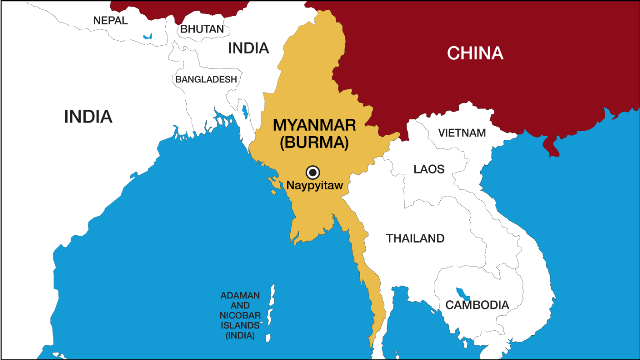
Roving Periscope: After Pak, Myanmar may now become China’s colony
Virendra Pandit
New Delhi: By successfully manipulating both Aung San Suu Kyi’s democratic credentials and the Army generals, China has thumb-nosed the divided West by toppling the democratically-elected government in Myanmar early this week.
Now China hopes to use armies in both Pakistan and Myanmar as its proxies to encircle India both in the east and the west—apart from the north where its People’s Liberation Army (PLA) has engaged the Indian Army in an eyeball-to-eyeball deadlock since May 2020 after a brief bloody confrontation.
The United Nations, the USA, India, and many other countries and organizations have condemned the military coup and demanded a return to democratic rule in Myanmar.
Formerly known as Burma, Myanmar’s partial return into the Chinese orbit makes its position vulnerable in the sub-regional organization, the Dhaka-headquartered Bay of Bengal Initiative for Multi-sectoral Technical and Economic Cooperation (BIMSTEC), founded in June 1997 through the Bangkok Declaration. Its other six member-states are Bangladesh, Bhutan, India, Nepal, Sri Lanka, and Thailand.
India had also been trying to facilitate Myanmar’s entry into the Association of Southeast Asian Nations (ASEAN) as a counterweight to Beijing’s moves in the region.
Indirect control of key Myanmar ports, like Kyaukphyu, will provide China an alternative route for energy flow from the Middle East, apart from Gwadar in Pakistan. This is important for China which is engaged in the South China Sea (SCS) against the combined might of the USA, Japan, Taiwan, Australia, and other nations of East and Southeast Asia.
Ever since America began to turn screws on China in the SCS, Beijing had begun to re-engage Myanmar. For this, China adopted its time-test deals to hook poor nations: it dangled a number of new multibillion-dollar deals.
In the first visit by a Chinese leader to Myanmar in two decades, President-for-Life Xi Jinping went to the neighboring nation in January 2020 to bring it back into Beijing’s fold. Myanmar had sidelined China for years and turned towards the West. But China managed to refill the breach between Myanmar and the West, which has long abandoned geopolitics and business-sense, replacing realpolitik by democratic rhetoric.
Xi announced several big investments in Myanmar, which is still trying to rebuild its infrastructure and jumpstart its economy after laboring under Western sanctions for about 20 years. The deals included, crucially, an announcement on the construction of the long-discussed deep-water port at Kyaukphyu.
Since 2011, Myanmar had begun to turn towards the West, reducing the long-time influence of Beijing’s support to the military rule in the country. But China wooed Myanmar back and drowned the West’s outcries on the alleged ethnic cleansing of Rohingya Muslims under the heaps of multibillion dollars. This issue re-alienated Myanmar from the West.
Once lionized as a democratic icon, Aung San Suu Kyi, was also wooed and systematically cut down to size as she chose to side with the nation’s mood against the Rohingyas.
But all is not lost for Myanmar. It knows how China has trapped poorer nations in debts and largesse. It, therefore, resisted Beijing’s offer to restart work on a hydroelectric project, and successfully ‘brought down’ Chinese investment from USD 7 billion to just USD 1 billion on the deep-water port so as to skip the larger and deeper Chinese debt trap.
For China, however, the Kyaukphyu port is more important than anything else in Myanmar for Beijing’s emerging geopolitical interests throughout the wider region. This deep-water port on the western coast of Myanmar, perched only a few hundred miles from the easternmost Indian-held islands, is Beijing’s latest in its spree of port acquisitions that underwrite the maritime half of its Belt and Road Initiative (BRI), media reported.
To reach out to the Middle East’s energy sources, China has been investing heavily to develop the Gwadar port in Baluchistan, Pakistan, as part of the larger China-Pakistan Economic Corridor (CPEC), the flagship project of the USD 200 billion Belt and Road Initiative (BRI).
Together with Gwadar and Kyaukphyu, Beijing hopes to bypass the vulnerable Strait of Malacca near Singapore. Kyaukphyu is the terminus of the huge natural gas pipeline China built to bypass Malacca and ensure energy supplies while avoiding the so-called Malacca Dilemma.
It was in this backdrop that the military coup became important.
On Monday (February 1), the Myanmar army staged a veiled coup, ousted the elected government, and declared a one-year state of emergency after detaining Aung San Suu Kyi and other leaders of the ruling National League for Democracy (NLD), rejecting its victory in the November 8, 2020, general elections. It was Myanmar’s second democratic poll since 2011 when the military junta’s long rule (the 1990s-2000s) ended in favor of a partial democracy.
The nation faced criticism for the alleged ‘genocide’ of the Rohingya Muslim community and the expulsion of 700,000 of them to neighboring countries. They were accused by the Buddhists majority of Myanmar of Islamic terrorism and separatism.
Cornered by the West, her government, whose survival depended on the army, re-engaged Beijing to secure investments.
Beijing plans to develop overland routes for the oil and gas pipelines via the Kyaukphyu special economic zone (SEZ) and the deep-sea port, which will allow it to bypass the SCS where the US, Japan, and others are challenging the sovereignty of marine routes.













